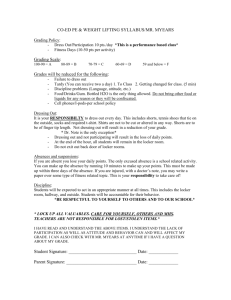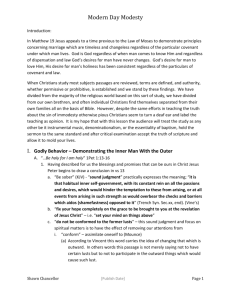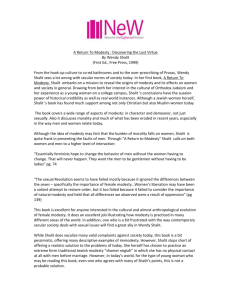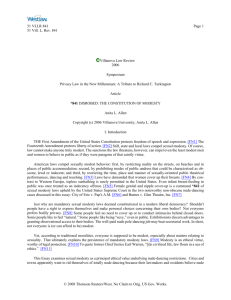definition essay final
advertisement
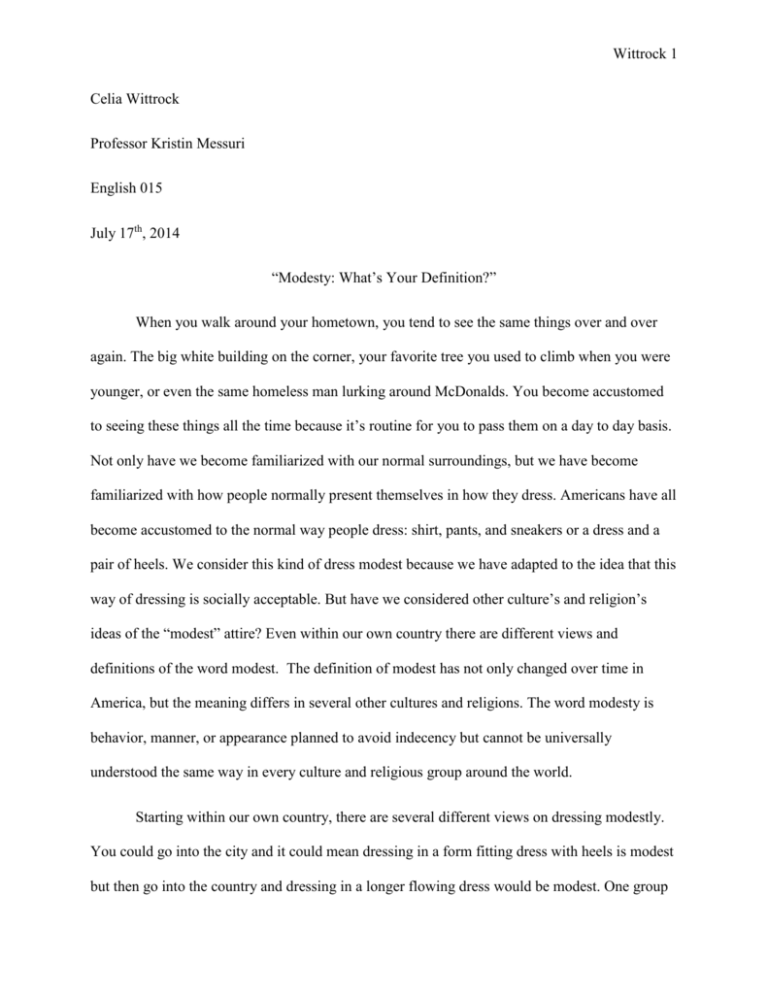
Wittrock 1 Celia Wittrock Professor Kristin Messuri English 015 July 17th, 2014 “Modesty: What’s Your Definition?” When you walk around your hometown, you tend to see the same things over and over again. The big white building on the corner, your favorite tree you used to climb when you were younger, or even the same homeless man lurking around McDonalds. You become accustomed to seeing these things all the time because it’s routine for you to pass them on a day to day basis. Not only have we become familiarized with our normal surroundings, but we have become familiarized with how people normally present themselves in how they dress. Americans have all become accustomed to the normal way people dress: shirt, pants, and sneakers or a dress and a pair of heels. We consider this kind of dress modest because we have adapted to the idea that this way of dressing is socially acceptable. But have we considered other culture’s and religion’s ideas of the “modest” attire? Even within our own country there are different views and definitions of the word modest. The definition of modest has not only changed over time in America, but the meaning differs in several other cultures and religions. The word modesty is behavior, manner, or appearance planned to avoid indecency but cannot be universally understood the same way in every culture and religious group around the world. Starting within our own country, there are several different views on dressing modestly. You could go into the city and it could mean dressing in a form fitting dress with heels is modest but then go into the country and dressing in a longer flowing dress would be modest. One group Wittrock 2 of people that receives a lot of attention for how they dress are the Amish. The Amish are a group of people mostly clustered in the north eastern part of the United States in states like Pennsylvania and Ohio. The Amish are a religious group that settled in the 18th century and also continue to live on traditional farms without modern technology. They are a private people who believe that God has called them to a simple life of faith, discipline, dedication and humility. Their traditional views reflect in how they dress as well. Amish clothing style encourages humility and modesty with long, flowing dresses for women and dark, plain suits for men. Both men and women must wear plain clothing without any embellishment or pattern of any kind so no attention is drawn to them. Women’s long hair must be covered as well with a bonnet. The Amish view of modesty might seem more extreme to what we’re used to, but this is considered normal dress for them. In this case, their modesty is heavily influenced by their conservative religious beliefs. Like the Amish, another group of people that have a more conservative view of modesty are Muslims. Men must practice relatively the same amount of modesty as working American men do but women in the Muslim culture have it much different. It is believed in the Muslim religion, Islam, that women should be mostly covered only leaving their face or sometimes just eyes seen by the public. The traditional dress called the hijab literally means “to cover” in Arabic. The hijab covers everything on the woman’s body except the face which is the more popular choice for most Muslim women. In some cases, women wear the burqa which is a veil that covers the face as well. In the Quran, the central religious text of Islam, God tells them to “lower their gazes and dress modestly” and to also to “draw their veils over their bodies”. (Quran 24:30-31) Muslims believe in this modest way of dressing because God has told them to do so, therefore, it is a strict rule in their culture. In some countries like Saudi Arabia and Wittrock 3 Qatar, it is a law that all women must wear the hijab. In this particular culture, their definition of modesty is reflected by their conservative religious beliefs. On the other hand, there are some cultures that don’t even consider modesty when dressing for the day (or lack thereof). In many African tribes, the appropriate everyday attire is a small patch of animal skin over the genitals, some jewelry, and a dash of body paint and they’re ready to take on the day. Most of Americans would view that as a little strange and too revealing, but they are simply more comfortable and accepting of showing most of their bodies. They have never had a reason to wear clothing since it’s very warm in Africa all year round. The tribes mostly wear a small patch of clothing over their genital area for protection. Some tribes, like the Zulu tribe, also require women to cover their breasts with cloth until they are engaged to represent that they are saving themselves for their husband. This culture is very different from than the Muslim and Amish culture we looked at before in that the African tribes don’t find anything wrong in not covering their bodies with clothing. Their culture is so adapted to their traditional clothing that only covers minimal space that they don’t see their way of dressing as not modest. In their eyes, they are just doing what they have been doing for centuries. Tradition is more important to these cultures rather than adopting western ways of life. Our definition of modesty in America, however, changes quite rapidly over time. If we went back in time to the 1950s and asked a man and a woman what they thought of our clothing in 2014, they would be astonished to see what people consider modest these days. Conservative pant suits have turned into tight dresses and full coverage bathing suits have become string bikinis. It would certainly be a shock to them. We as a nation don’t collectively have one definition of the word modest, but each individual has their own definition. We all shop for our own clothes, have our own preferences, and have our own styles so it would be wrong to say that Wittrock 4 there is one definition of modesty we have to abide by. One person could think that jeans and a tshirt is modest but another person could think that daisy dukes and a pair of heels is modest. Our definition of modest will always be changing and never be the same from person to person. Whether a person’s belief is to cover most of their bodies to remain modest or to wear limited clothing to keep the nation’s tradition alive, we are all considered to be modest based on what our culture has defined it to be. Wittrock 5 Works Cited: Kapff, Uli. "Zulu Clothing." Zulu Culture. Zulu Culture, 5 Sept. 2011. Web. 17 July 2014. Powell, Albrecht. "Amish 101 - Amish Culture, Beliefs & Lifestyle." About.com Pittsburgh. About.com, 15 July 2010. Web. 16 July 2014. Stacey, Aisha. "Why Muslim Women Wear The Veil." The Religion of Islam. The Religion of Islam, 28 Sept. 2009. Web. 17 July 2014.

